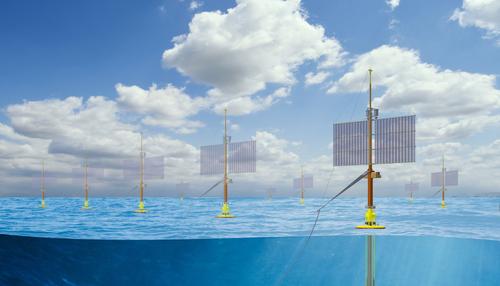DoE-Backed Startup Puts a Twist on Offshore Wind Energy
Accio Energy has created a novel, turbine-less wind energy technology for offshore systems that uses electro-hydrodynamic charge separation principles.
May 20, 2016
So far, rotor-based turbine technologies have been the main generators of wind energy. But researchers have been exploring different options, away from the typical design, as the way forward in terms of cost-efficiency and environmental impact.
To that end, the Department of Energy (DoE) has put its money behind a new system by startup Accio Energy. The company's novel technology for offshore systems uses a combination of static panels and water drops to generate energy.
Accio Energy was founded in 2008 by serial entrepreneur Dawn White to combine wind-energy technology with manufacturing expertise to disrupt the cost model for offshore wind energy, according to the company. The Accio system uses what’s called electrohydrodynamic (EHD) charge separation principles rather than typical wind-turbine rotors to generate electricity.

Startup Accio Energy has developed a novel wind-energy generating system that uses an electrical reaction formed by salt-water droplets to create energy. The system does not use typical turbines but static panels instead.
(Source: Accio Energy)
EHD technology uses the wind to separate a mist of positively charged salt-water droplets from excess electrons that form a high-voltage direct current source, according to Accio. As a result of this, a large negative potential on the source panel and an electrical field with 200,000-volt potential appear, which the wind works against to continue moving charge.
The systems operate on seawater, can be deployed in deep water, and survive expected storm conditions, the company said. Accio plans to fabricate the systems using high-volume, low-cost automotive heritage advance manufacturing.
Benefits of the system that enable it to significantly drive down the cost of wind power include the elimination of moving parts—i.e., large rotors—that must be transported and installed, according to Accio. Moreover, the panels themselves can be easily combined into larger arrays, which means the system can scale efficiently from kilowatt to gigawatt systems.
READ MORE ARTICLES ON RF ENERGY HARVESTING:
Although Accio’s technology is some time away from full commercial potential, the company is edging toward its goals. The company said it is working on its first offshore, floating demonstration of an EHD wind generator at kilowatt output levels. As part of the project, Accio will also collaborate with the University of Maine’s Advanced Structures and Composites Center to design, build, and test progressive prototypes and develop offshore validation of performance, scalability, and operability in real-world conditions.
Accio’s plans and technology have been enough to attract some high-profile backing from the US government to development and commercialize its technology. The company recently received $4.5 million in funding from the DoE’s Advanced Research Projects Agency (ARPA-E), which it plans to use to further develop its technology.
Other backing has come from the National Science Foundation (NSF), the Defense Advanced Research Projects Agency (DARPA), the State of Michigan Public Service Commission, and the National Center for Manufacturing Sciences, as well as private investors.
Elizabeth Montalbano is a freelance writer who has written about technology and culture for more than 15 years. She has lived and worked as a professional journalist in Phoenix, San Francisco and New York City. In her free time she enjoys surfing, traveling, music, yoga and cooking. She currently resides in a village on the southwest coast of Portugal.
About the Author(s)
You May Also Like
.jpg?width=300&auto=webp&quality=80&disable=upscale)


